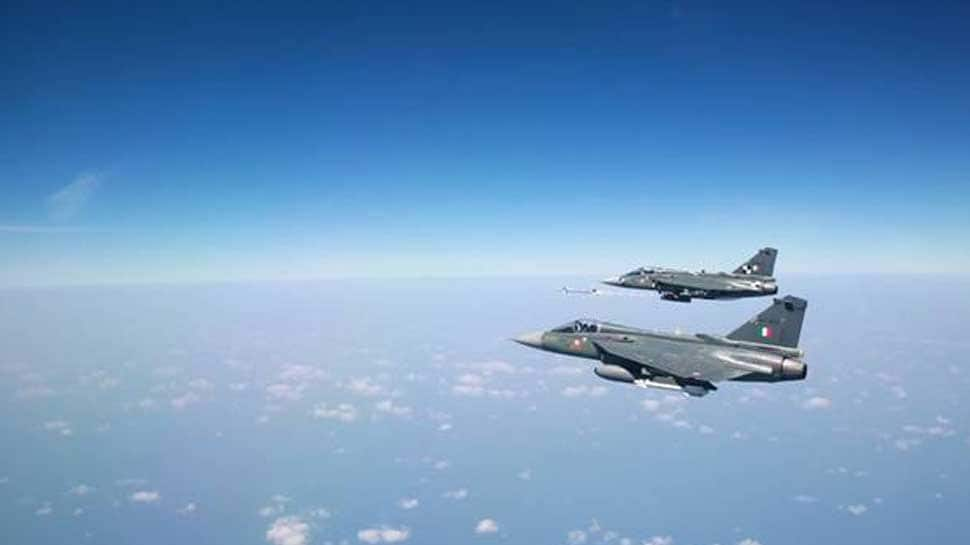New Delhi: Light Combat Aircraft (LCA) Tejas, Indian Air Force's indigenous supersonic jet, is well on its way to becoming one of the most potent fighters in the four-plus generation combat aircraft class. Just days after the IAF tested its war-waging capabilities in a possible two-front scenario involving Pakistan and China during Gagan Shakti 2018, the Tejas took a step forward towards achieving the Final Operational Clearance (FOC) by successfully firing the Israeli Derby Air-to-Air Beyond Visual Range (BVR) missile for the second time. The successful test expanded the firing envelope as well demonstrated safe operation of the Tejas during missile plume ingestion into the aircraft engine under worst case scenarios.
Wing Commander Siddharth Singh was the fighter pilot who fired the 118-kg Derby missile from his LCA Tejas on April 27, 2018, from the firing range off the Goa coast after an exhaustive study of the missile separation characteristics and plume envelope. During the 13-day Gagan Shakti 2018 exercise, Tejas was extensively tested to fine-tune its combat potential and the IAF leadership expressed its satisfaction with the fighter's performance.
Tejas had on May 12, 2017, fired the Derby Air-to-Air BVR missile for the first time in RADAR guided mode at the Interim Test Range (ITR), Chandipur in Odisha. The missile launch was performed in Lock ON after Launch mode for a BVR target in the look down mode and the target was destroyed.
The FOC of Tejas is dependent on Derby's integration. The aircraft was tracked by two other Tejas aircraft to capture the firing event in the specially instrumented high-speed cameras for detailed analysis and comparison with the simulation model for validation.
All about Derby BVR missile:
-Derby is a short to medium range BVR Air-to-Air missile.
-Developed jointly by Israeli armament development agency Rafael and Israel Aircraft Industries MBT has a maximum effective range of about 50 km.
-Derby is an active radar air-to-air missile for the fighter aircraft and has the capability to be launched at a target day or night and in all weather conditions.
-It has look-down/shoot-down capability, fire and forget mode and an advanced ECCM tailored to the customer's operational requirements.
-The missile's light weight allows it to be adapted to various modern fighter aircraft.
-It is a dual-use missile (air-to-air and surface-to-air).
-The missile has a launch weight of 118 kg, is 3.8 metres long, wingspan of 64 cm and a diametre of 16 cm.
The entire planning, practice sorties and final firing was carried out by DRDO's autonomous society – Aeronautical Development Agency (ADA) and its National Flight Test Centre (NFTC) officials Air Commodore JA Maolankar and Group Captain A Kabadwal, IAF, Directorate General of Aeronautical Quality Assurance, Hindustan Aeronautics Limited and INS HANSA.
Based on the successful integration and demonstration, Regional Centre for Military Airworthiness (RCMA), a unit of DRDO has cleared the series production aircraft of Flying Daggers Squadron 45, to be equipped with Derby operational capability. LCA Tejas has successfully completed a series of captive flight trials to clear Derby for the full operational capability in the entire FOC envelope.
During the Gagan Shakti 2018 exercise, eight Tejas jets were deployed. IAF sources said there were minor technical issues with a few Teajs jets, but at least six Tejas had flown six sorties daily like any other platforms including the Sukhoi Su-30 MKI, Mirage 2000 and MiG-29 fighters.
The exercises also helped hone the integration of the nuclear-capable hypersonic BrahMos and anti-ship Harpoon missile platforms into their intended strike roles. Gagan Shakti 2018 was especially critical for IAF in relation to its capabilities along the Line of Actual Control (LAC) with China as the region's high altitude has an adverse impact of a fighter's capabilities.
The IAF is on its way to induct 324 Tejas to shore up it depleting squadron strength. The IAF, for years, maintained that the Tejas fighters are not combat-ready even after three decades of development given its limited range.
But it has already committed to buying at least 123 Tejas fighters for Rs 75,000 crore from the Hindustan Aeronautics Limited (HAL). The IAF, however, has demanded that the Tejas Mark II jet, which is still on the drawing board, should be entirely “new fighters” with “better avionics, radars, enhanced weapons carrying capacity and powerful engines”.
IAF fighter pilots say the current single-engine Tejas has limited “endurance” of just an hour, with a “radius of action” of only 350-400-km and weapon-carrying capacity of 3-tonne. While the other single-engine fighters such as Swedish Gripen-E have triple the endurance and double the weapon-carrying capacity.
















